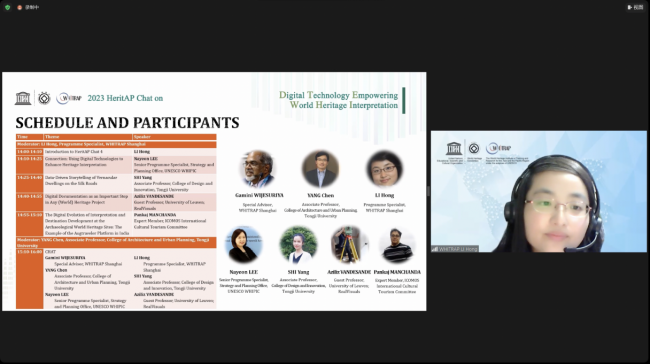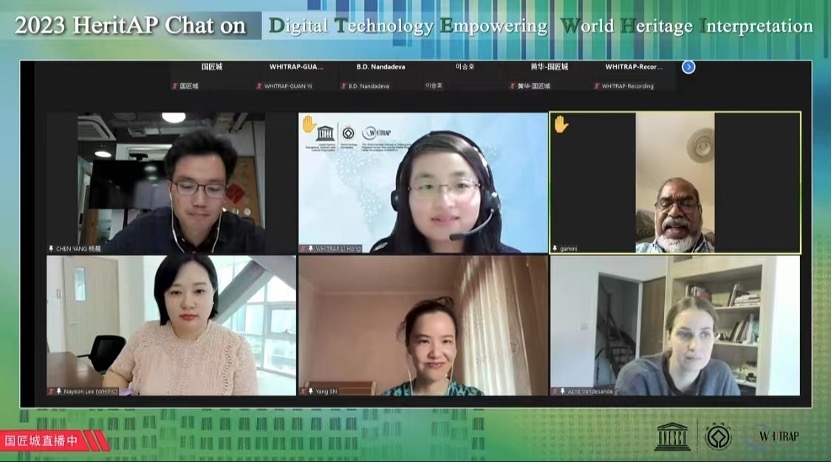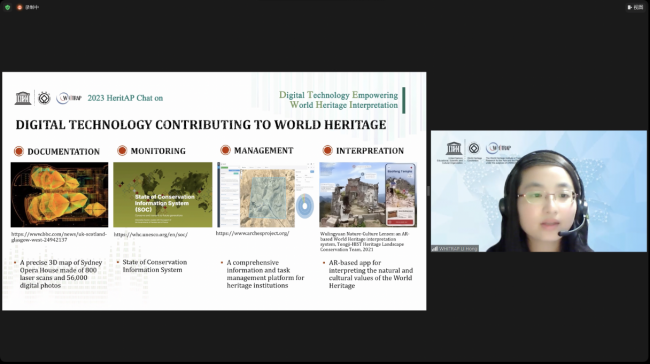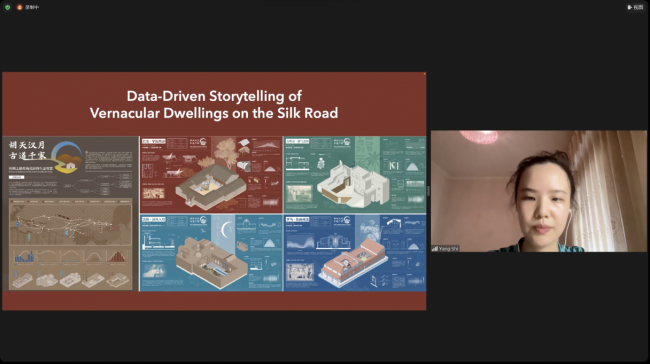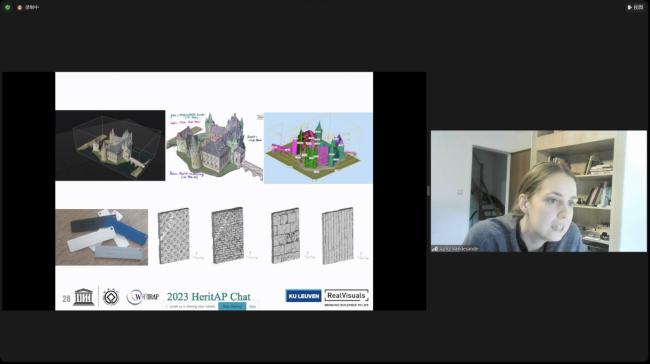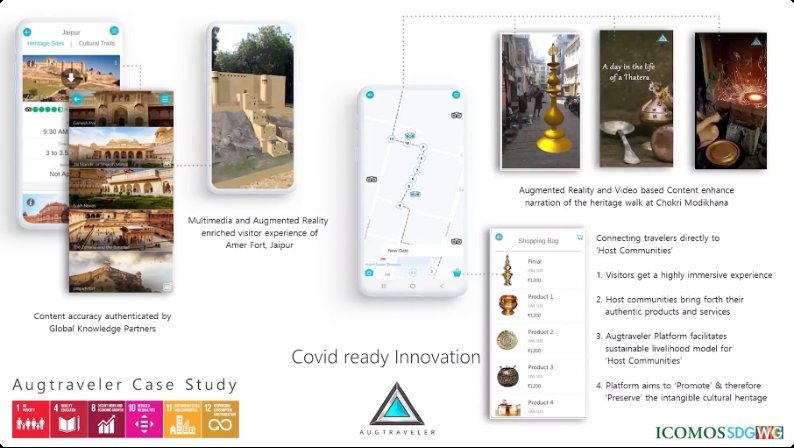| 2023 HeritAP Chat on Digital Technology Empowering World Heritage Interpretation |
| PublishDate:2023-08-25 Hits:17026 |
On July 27, the World Heritage Institute of Training and Research for the Asia and the Pacific Region under the auspices of UNESCO, Shanghai Center (WHITRAP Shanghai) organized the 4th Heritage Asia and the Pacific (HeritAP) Chat on “Digital Technology Empowering World Heritage Interpretation”.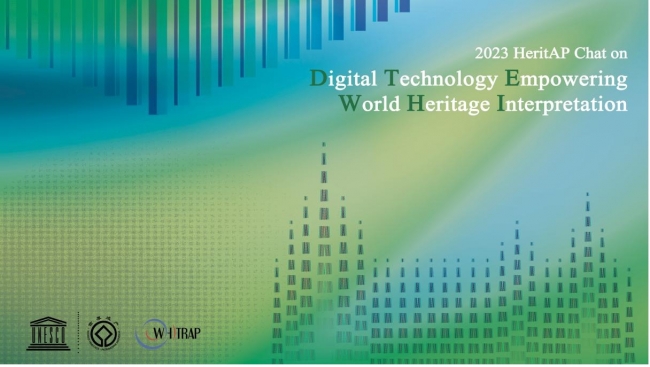 Event cover
Seven experts were invited to attend the activity, including Mr. YANG Chen (Associate Professor, College of Architecture and Urban Planning, Tongji University), Mr. Gamini WIJESURIYA (Special Advisor, WHITRAP Shanghai), Ms. LI Hong (Programme Specialist, WHITRAP Shanghai), Ms. Nayeon LEE (Senior Programme Specialist, Strategy and Planning Office, UNESCO WHIPIC), Ms. SHI Yang (Associate Professor, College of Design and Innovation, Tongji University), Ms. Aziliz VANDESANDE (Guest Professor, Faculty of Engineering Science, University of Leuven; RealVisuals), and Mr. Pankaj MANCHANDA (Expert Member, ICOMOS International Cultural Tourism Committee). The activity was conducted through two sessions - case presentation and free chat. Ms. LI Hong and Mr. YANG Chen were the moderators of these two sessions respectively. In total 26 audiences attended the ZOOM Meeting and about 1400 watched the live stream.
Schedule and participants
Online group photos
Ms. LI Hong presenting
“2023 HeritAP Chat on Digital Technology Empowering World Heritage Interpretation”
During the first part of case presentation, four expert speakers introduced their cases of digital technology empowering World Heritage interpretation from different perspectives and in different local contexts. Ms. Nayeon LEE focused on using digital technologies to enhance heritage interpretation. She introduced the involvement of technology in interpretation and presentation of heritage and pointed out that the number of times exposed to heritage is crucial for the public to build their awareness and turn them from mere visitors to heritage advocators. Digital technologies provide an accessible platform for the public and connect past and present values. In the case of Baekje Historic Area, the heritage site created a digital audio guide on mobile phones to improve visitors’ understanding of the heritage and recognition of the heritage values. After six months of construction, design, and data collection, the application was released and provided numerous visual contents and interactive communication, combined with edutainment and gamification materials. The application was effective in connecting the heritage and people, while it could still improve in interactive communication, where a commenting section could be added to better reflect the present values of the heritage site. 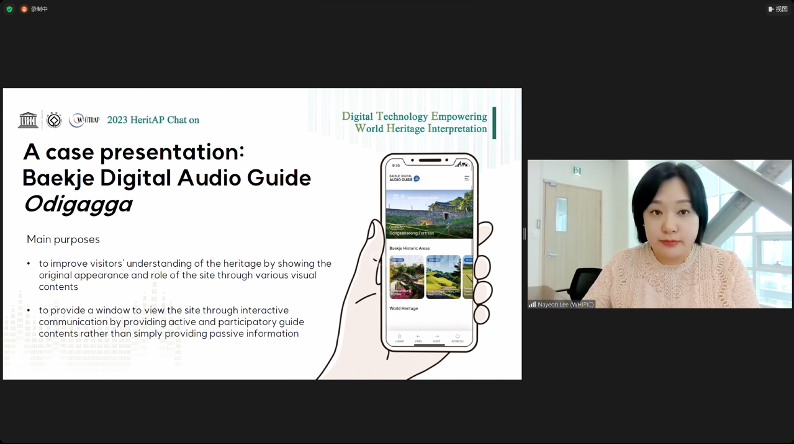 Ms. Nayeon LEE presenting
“Connection: Using Digital Technologies to Enhance Heritage Interpretation”
Ms. SHI Yang presenting
“Data-Driven Storytelling of Vernacular Dwellings on the Silk Roads” Ms. Aziliz VANDESANDE shared three cases of digital documentation as an important step in heritage project. In the first case, the team worked together with local government, park managers and tribes to further developed Robert Waller's cultural property risk analysis model and adjusted it specifically for the sites of Petra Archaeological Park for risk mapping, assessment and management. In the second case called ILUCIDARE, they focused on capacity building and knowledge exchange through early training of GIS technology and co-construction of inventory with local talented people, and further put these KULLAS buildings as a typology on the transnational World Heritage nomination. In the last case, they used digital technologies including drones, total stations and static scanners to document a castle, developed a basic application and a 3D print model of the castle with different sensible textures for people with physical disabilities to visit and feel every part of the castle.
Ms. Aziliz VANDESANDE presenting
“Digital Documentation as an Important Step in Any (World) Heritage Project” Mr. Pankaj MANCHANDA’s presentation was divided into two sections to show the digital evolution of interpretation and destination development at the archaeological World Heritage sites. In the first section, he introduced the AUGTRAVELER, a startup project which adopts new-age immersive technologies of augmented reality, virtual reality, geolocation and analytics. While designing and evolving the solution and platform for immersive travel experience, the vision of this project takes the attributes of happiness and well-being of local stakeholders into consideration, which are aligned with the United Nations’ Sustainable Development Goals of 4,8,10,11. In the second section, he shared another project called THENZAWL Calling, where they collaborated with Mizoram to create a sustainable and win-win cultural and natural heritage tourism for visitors and locals. The project could make the destination more discoverable to visitors by geotagging its tangible and intangible heritage, as well as help the local travel businesses build their digital presence and online curated marketplace.
Mr. Pankaj MANCHANDA presenting
“The Digital Evolution of Interpretation and Destination Development at the Archaeological World Heritage Sites: The Example of the AUGTRAVELER Platform in India”
In the second part, the free chat between six expert speakers focused on substantive discussions on how to empower World Heritage interpretation through digital technology. The keywords include whole life-cycle, appropriate funds, data management, effectiveness of products, creative experience and talents. The chat began with the short speech from Mr. YANG and Mr. WIJESURIYA. As the moderator of this session, Mr. YANG summarized the former presentations to draw the conclusion that digital technology provides novel platforms which break the restrictions of space and time and excellent digital twins of World Heritage. It also converts the interpretation from object oriented to user oriented and provides diverse narratives in the interpretation process. Mr. WIJESURIYA highlighted three principles to follow in heritage interpretation. Firstly, consider interpretation as an integral part of heritage management. Secondly, interpretation has to be guided by comprehensive understanding of heritage sites. Thirdly, it should deliver comprehensive resources, not only for one particular community or one society. He appreciated that all the presentations had these principles embedded. Regarding the funds and sustainable operation of digital technology in World Heritage interpretation, Ms. LI raised two questions about the Baekje Digital Audio Guide Odigagga project introduced by Ms. LEE: Who invests in the project and how the project sustains in a proper way? Dr. LEE explained that this project is a combination work with eight serial heritage sites so there is a large amount of funds provided by Korean government. Baekje History Area has an integral center to collaborate the management and conservation of eight sites and update the application. She pointed out that during the three-year improvement of the application, the basic system was already done in the first year, then the following work was to keep improving the method to showcase the value of the sites and update different activities that visitors can do on the sites with the application. Ms. VANDESANDE agreed that funding is important and also shifted to another important reflection on the ownership, copyright and management of the data. She insisted that it’s essential to make a data management plan before data collection according to different circumstances. Sufficient funds are required in big projects, while free and open-source software is necessary when working on projects with local communities, because local people can be taught to use the inventory and add new information to achieve capacity building. Meanwhile, she warned that the copyright of the data should be protected to prevent arbitrary use by private websites and illegal commercial activities for profit. In this case, Mr. YANG pointed out that’s why UNESCO puts very important chatters on the conservation of digital heritage. He also added that heritage sites of different sizes have archives of different dimensions, some in 3D documentations while others in 2D. It’s important to make a whole life-cycle plan, such as training, workshops and local capacity building programs in terms of digital documentation, data storage and management. In terms of the creative experience and products of World Heritage interpretation empowered by digital technology, Mr. YANG and Ms. SHI had a discussion with examples. Mr. YANG was very concerned about the effectiveness of the input and output of digital technology, and he thought it depends on what kind of experience, connections or interpretations we want our users to get from the application. For some projects, we can choose very simple technology just like QR code voice guide while for others there may be more complicated technology like AR, VR or XR. Ms. SHI introduced that narrative visualization has great potential to help review unique insights and stories inherent in heritage sites, such as artifacts, architecture, history and culture. She emphasized that digital interpretation should provide different, creative and novel vision and experience for visitors who cannot really see from the physical sites, and enhance rather than override traditional exhibits. For example, interactive maps and timelines can contextualize events and track changes, data visualization of archaeological findings or architectural details can highlight key characteristics, and interactive data stories can create individual connections between audiences and the stories. When it comes to the extensive level of interpretation, connection and experience and the selection of appropriate technologies, Ms. LEE reviewed that the concept of heritage interpretation was initially from the academia, and now it could be the very first step in the evaluation of the heritage. She emphasized the most important digital technology for interpretation is documentation skill, because the more information we got, the more effectively we can interpret the heritage. In that case, she thought archiving and inventory would be the best option that relative experts can use for digital technology. Ms. VANDESANDE remained skeptical towards the genuine interest of a broader audience who visit digital heritage sites except for experts. Took a pilot project in South America for example, she pointed out the obstacle that the team carried out valuable and great work with local people to restore the entire village in Adobe architecture and local laboratory, but got few likes on social media. Therefore, she called for more research or practice on to what extent people are actually interpreting or intaking information from the digital application of heritage sites. Last but not least, Ms. LI on behalf of WHITRAP Shanghai and HeritAP, appreciated the presentation and discussion of all experts and the participation of all the audiences. During this heritage chat, a lot of new issues were raised and discussed, such as the whole life-cycle and different circumstances of digital heritage projects, the ownership and management of data, the creative experience, products and credible audiences of World Heritage interpretation empowered by digital technology. By sharing professionals’ experiences and conducting free chat, heritage practitioners could better respond to the management and conservation of the sites in the digital age. 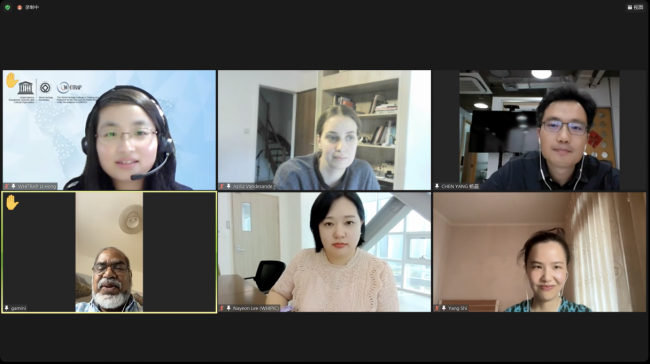 Participants’ chat
供稿:李泓
Contributed by: LI Hong
排版:肖明格(实习)
Edited by: XIAO Mingge (Intern)
|
- News | WHITRAP Shanghai and CNR-ISPC bilateral meeting
- News | WHITRAP meets Cité de l’Architecture et du Patrimoine
- WHITRAP Hosting "Workshop on Preliminary Assessment for National Focal Points of the Asia Region" in Chengdu
- WHITRAP Shanghai meets UNESCO
- INTERNATIONAL CONFERENCE PRELIMINARY ANNOUNCEMENT & CALL FOR PAPERS
- Observation of the 46th Session of the World Heritage Committee
Copyright © 2009-2012 World Heritage Institute of Training and Research-Asia and Pacific (shanghai)


